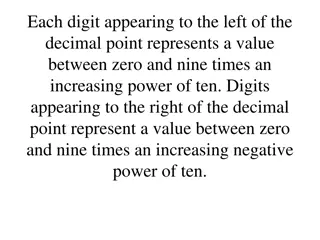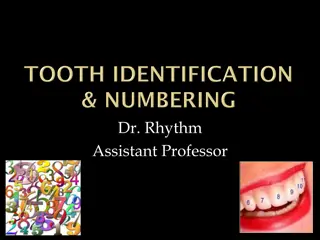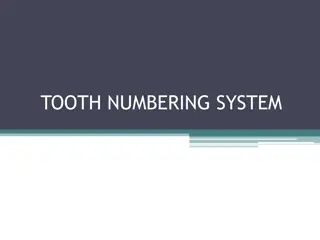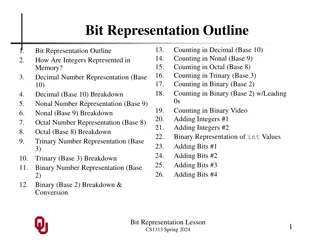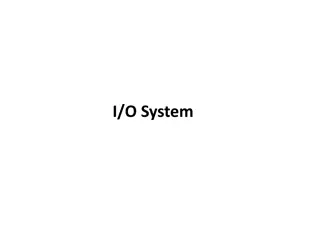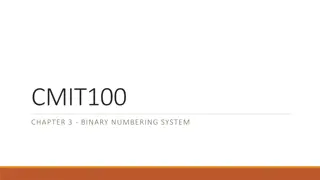
Understanding Semiconductor Devices Numbering Systems
Explore the European-based pro-electron system and the American-based JEDEC system for semiconductor devices, including how the numbering systems work, materials, device types, and applications. Learn about serial numbers and suffixes used in naming conventions.
Download Presentation

Please find below an Image/Link to download the presentation.
The content on the website is provided AS IS for your information and personal use only. It may not be sold, licensed, or shared on other websites without obtaining consent from the author. Download presentation by click this link. If you encounter any issues during the download, it is possible that the publisher has removed the file from their server.
E N D
Presentation Transcript
Semiconductor Devices Numbering Systems
Semiconductor Devices Numbering Systems THE THE EUROPEAN BASED PRO- ELECTRON SYSTEM. The American based JEDEC system JAPANESE BASED JIS SYSTEM
The European based pro-electron system. This system uses the following format: Two letters ,[letter],serial Number,[suffix]: The 1st letter specifies the semiconductor material: A-Germanium B-Silicon C-Gallium Arsenide R-Compound Materials
The 2st letter specifies the type of device: N-Photo coupler P-Light detector Q-Light emitter R-Switching device, low power S-Transistor, low power switching T-Switching device power U-Transistor, switching power W-Surface acoustic wave device X-Diode, multiplier Y-Power devices , Diode, rectifying Z-Diode voltage reference A-Diode, low power or signal B-Diode, variable capacitance C-Transistor, audio frequency low power D-Transistor, audio frequency power E-Diode, tunnel F-Transistor, high frequency low power G-Miscellaneous devices H-Diode, sensitive to magnetism K-Hall effect device L-Transistor, high frequency power
Third latter If present this indicates that the device is intended for industrial or professional rather than commercial applications. It is usually a W X Y Z. Serial Number The serial number runs from 100-9999. Suffix If a suffix is present then this indicates the gain group as below: A-low gain B-medium gain C-high gain No suffix ungrouped (any gain). Example-BFY51A
The American Based JEDEC System The JEDEC system,(Joint Electronic Device Engineering Council). This system has the following format: Digit, Letter Serial Number,[suffix]: Digit- The 1st digit designates the amount of P-N junction in the device. So a device starting with 2 would contain 2 P-N junctions and would most likely be either a transistor or a FET. common part numbers are given below: 1-Diode 2-BJT or FET 3-Double gate MOSFETs ,SCR s 4-Opto couplers
Letter The letter is always N , and the remaining figures contain the device serial number. Serial Number- The serial number runs from 100 to 9999. Suffix- If a suffix is present then this indicate the gain group as below: A-low gain B-medium gain C-high gain No suffix ungrouped (any gain). Example-1N4007 would be a DIODE and 3N201 would be a double gate MOSFET.
The Japanese Based JIS System The Japanese Industrial Standard has the following format : Digit ,Two Letters ,Serial Numbers,[suffix]: Digit- This indicates the amount of P-N junctions. So a device starting with 2 would contain 2 P-N junctions and would most likely be either a transistor or a FET. common part numbers are given below: 1-Diode 2-BJT or FET 3-Double gate MOSFETs ,SCR s 4-Opto couplers
Letter- The letters indicate the intended application for the device according to the following code: SA : PNP HF transistor SC : NPN HF transistor SB : PNP AF transistor SD : NPN AF transistor SE : Diodes SG : Gunn devices SJ : P-channel FET/MOSFET SM : Triac SR : Rectifier ST : Diodes SZ : Zener diodes SF : Thyristors SH : UJT SK : N-channel FET/MOSFET SQ : LED SS : Signal diodes SV :Varicaps
Serial number- The serial number runs from 10 to 9999. Suffix- The (optional ) suffix indicate that the type is approved for use by various Japanese organization.



